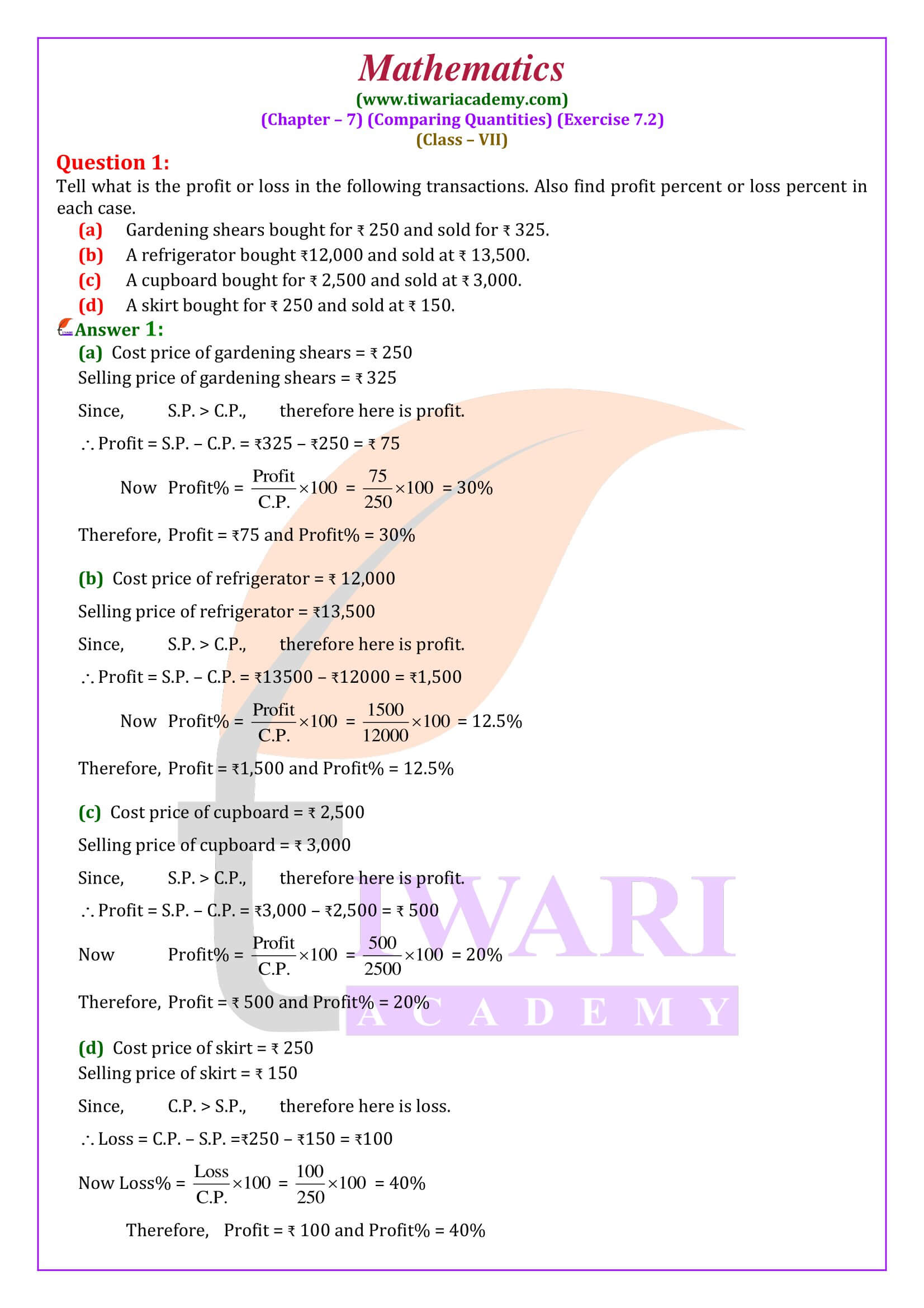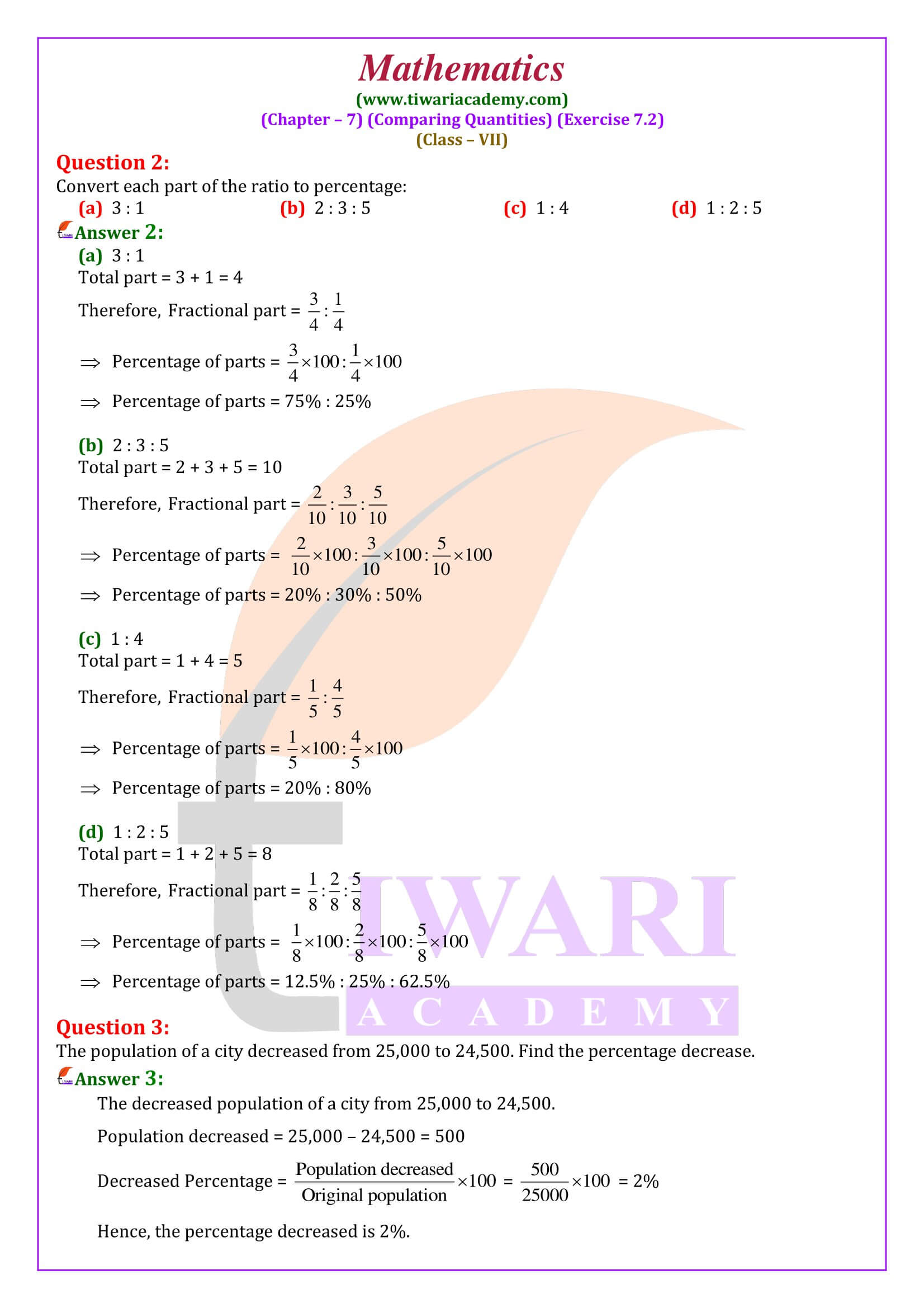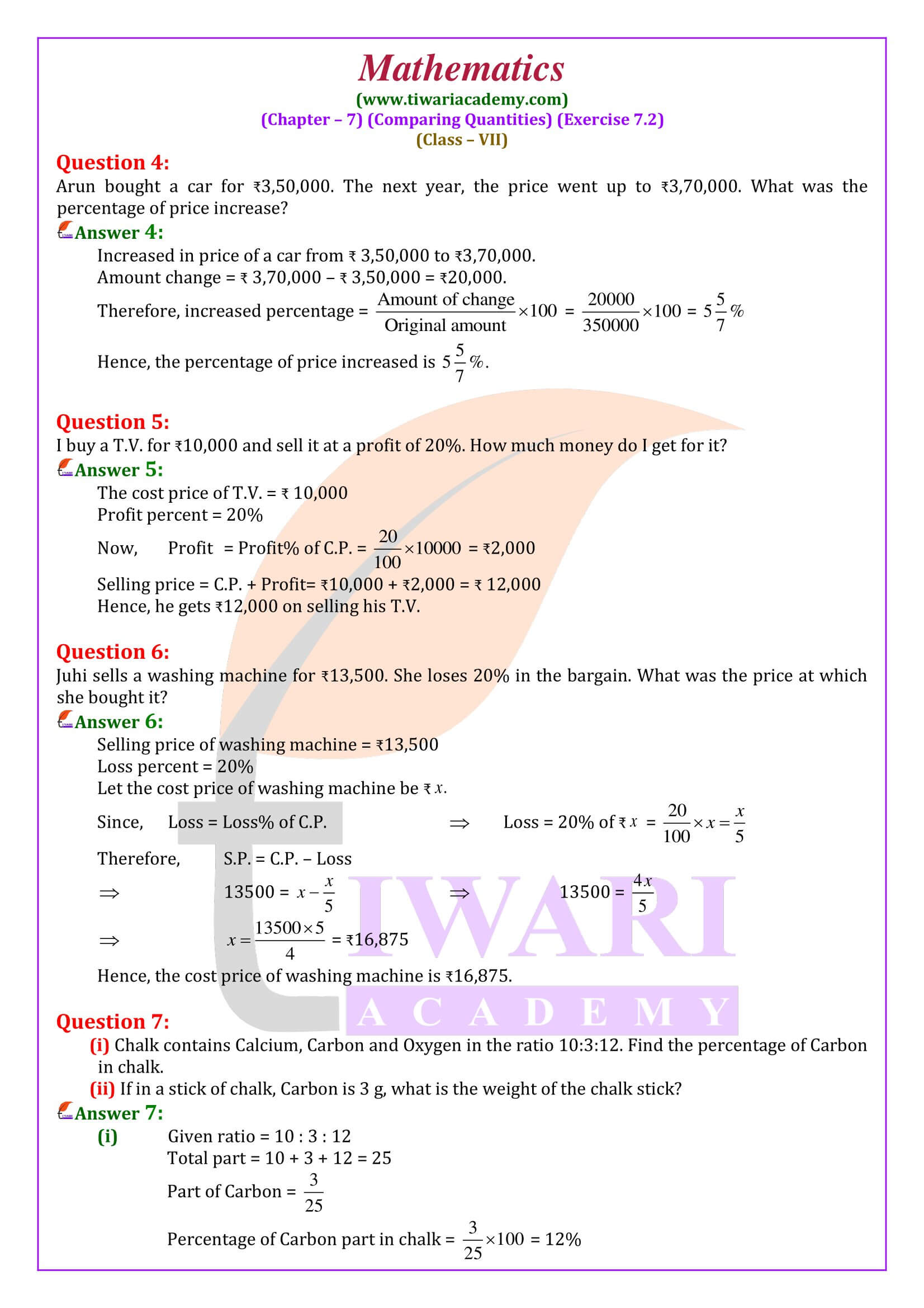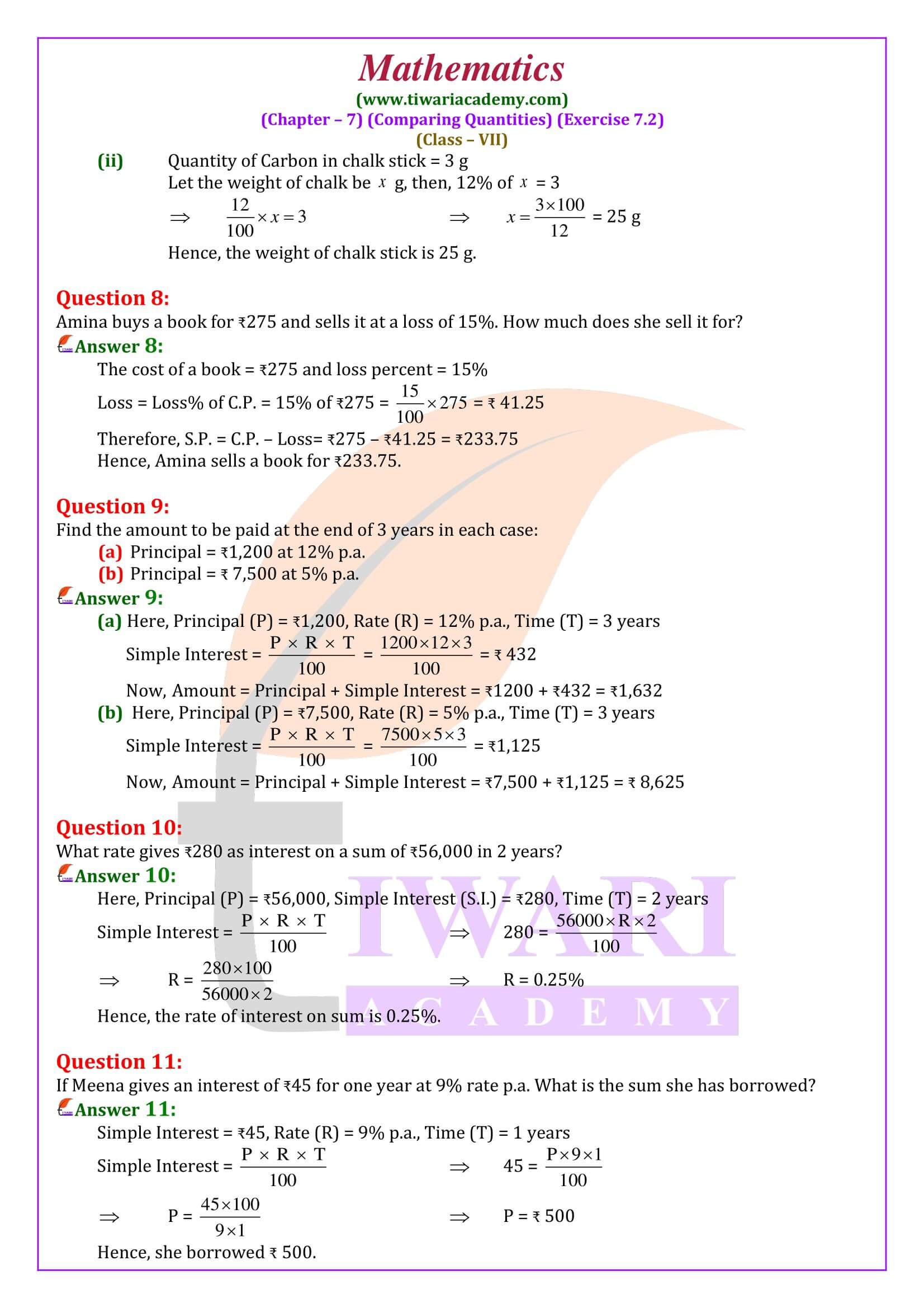NCERT Solutions for Class 7 Maths Chapter 7 Exercise 7.2 Comparing Quantities in English Medium as well as Hindi Medium. Get here the revised solution of ex. 7.2 class 7th mathematics based on rationalised syllabus and new textbooks issued for CBSE 2025-26.
NCERT Class 7 Maths Exercise 7.2 Solution in Hindi and English Medium
| Class: 7 | Mathematics |
| Chapter: 7 | Exercise: 7.2 |
| Chapter Name: | Comparing Quantities |
| Content Type: | Images, Text and Videos |
| Academic Session: | CBSE 2025-26 |
| Medium: | English and Hindi Medium |
Class 7 Maths Chapter 7 Exercise 7.2 Solution
All the solutions are updated for session 2025-26 according to latest CBSE Syllabus 2025-26. In class 8 math NCERT book exercise 7.2, questions are based on CP, SP, Profit, and Loss concepts. Most of the questions contains the practical problems in daily life.
Class 7 Maths Exercise 7.2 Solution in Videos
Profit
Profit describes the financial benefit realized when revenue generated from a business activity exceeds the expenses, costs, and taxes involved in sustaining the activity in question. Any profits earned funnel back to business owners, who choose to either pocket the cash or reinvest it back into the business.
Loss
A loss is an excess of expenses over revenues, either for a single business transaction or in reference to the sum of all transactions for an accounting period.
Class 7 Maths Exercise 7.2 Extra Questions
A tricycle was purchased for Rs. 1120 and sold for ₹ 1260. Find the gain and gain per cent.
CP of the tricycle = ₹ 1120.
SP of the tricycle = ₹ 1260.
Since (SP) > (CP),
So, there is a gain.
Gain = (SP) – (CP) = ₹ (1260 – 1120) = ₹ 140.
Gain% = (gain/CP) x 100 %
Gain% = (140/1120) x 100 % = 12.5 %
Hence, gain = ₹ 140 and gain% = 12.5%.
Find the interest on ₹ 1500 for 2 years at 15% per annum.
Interest on ₹ 100 for 1 year = ₹ 15
So, Interest on ₹ 1 for 1 year = ₹ 15/100
So, Interest on ₹ 1500 for 1 year = ₹ (15/100) x 1500
So, Interest on ₹ 1500 for 2 years = ₹ (15/100) x 1500 x 2 = ₹ 450
Some Terms Related to Profit and Loss
Cost Price (CP)
The price at which an article is purchased is called its cost price, written as cp.
NOTE: The overhead expenses like sales tax, labour charges, cartages, etc., are included in the cost price.
Selling Price (SP): The price at which an article is sold is called its selling price, written as SP.
Profit or Gain
If (SP) > (CP), then the seller has a gain or a profit.
Gain = (SP) – (CP).
Gain is always reckoned on CP.
Gain on Rs. 100 is called gain per cent.
Gain Formula:
Gain% = (gain/cp) x 100 %
Class 7 Maths Exercise 7.2 Important Questions
How do you calculate profit or loss?
To calculate the accounting profit or loss you will:
add up all your income for the month.
add up all your expenses for the month.
calculate the difference by subtracting total expenses away from total income.
and the result is your profit or loss.
How do you calculate loss?
Take the selling price and subtract the initial purchase price. The result is the gain or loss. Take the gain or loss from the investment and divide it by the original amount or purchase price of the investment. Finally, multiply the result by 100 to arrive at the percentage change in the investment.
How do you explain simple interest?
Simple interest is interest calculated on the principal portion of a loan or the original contribution to a savings account. Simple interest does not compound, meaning that an account holder will only gain interest on the principal, and a borrower will never have to pay interest on interest already accrued.
Loss
If (SP) < (CP), then the seller has a loss. Loss is always reckoned on CP. Loss on Rs. 100 is called loss per cent. Loss% = (loss/cp) x 100 %
Relevant Formulae
(i) Gain = (SP) – (CP)
(ii) Loss = (CP) – (SP)
(iii) Gain% = (gain/CP) x 100 %
(iv) Loss% = (loss/CP) x 100 %
(v) SP = {(100 + gain%)/100} x CP
(vi) SP = {(100 + loss%)/100} x CP
(vii) CP = {100/ (100 + gain%)} x SP
(vii) CP = {100/ (100 + loss%)} x SP
Sometimes, a shopkeeper has to bear some additional expenses such as transportation charges, labour charges, maintenance charges etc. for the items before they are sold. Such charges are called overhead charges.
Thus, Effective cost price = cost price + overhead charges.
To Find SP When CP and Gain% or Loss% are Given
We can find the selling price by unitary method or by applying the formula.
SP = {(100 + gain%)/100} x CP
SP = {(100 + loss%)/100} x CP
Simple Interest (S.I.)
Sometimes we need to borrow money from a bank or a moneylender for a specified period of time. At the end of this period, we have to pay back the money which we had borrowed plus some additional money for using the lender’s money.
Principal: The money borrowed is called the principal or the sum.
Interest: The additional money paid by the borrower is called the interest.
Amount: The total money paid by the borrower to the lender is called the amount. Clearly, Amount = (Principal + Interest).
Rate: The interest on Rs. 100 for 1 year is known as the rate per cent per annum.
Simple Interest: If interest is calculated uniformly on the original principal throughout the loan period, it is called simple interest.
Formulae
Let principal = Rs. P, Rate = R % per annum and time = T years.
Then, SI = (P x R x T)/100, where SI stands for simple interest.
From this formula, we have:
(i) P = (100xSI)/ (R x T)
(ii) R = (100xSI)/ (P x T)
(iii) T = (100xSI)/ (P x R)






